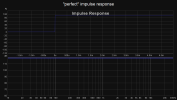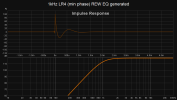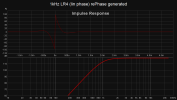I have actually attached the measurements in one of my earlier posts in this thread - if you open them you will see that the LP filter provides almost the same frequency response (there is fraction of dB difference) as the MP filter - so actually it does what it has to do
I suspect that what we see happening is what
@Kvalsvoll was saying above, that 'simply' the ringing is shifted to the 'left' instead of shifting it to the 'right' - which is clearly visible on the wavelet diagrams; it is just that as you can see on the diagrams the amount of shift is far less vs with the MP filter shifting it the to 'right'
Re. taps and frequency response: frequency response is 48kHz and I cannot tell you the number of taps since I don't know how many taps CraveEQ is using under the hood
Hi ppataki,
Please forgive me if I'm barking up a tree, but I think the CraveEQ is maybe doing some funky things that don't fit normal ways of thinking about minimum phase and linear phase.
I'm also getting strange results in REW from the mdat you gave in #6, and they also don't match the wavelets in the thread starter.
Strange results first:
I removed the 1/12th smoothing on the measurements, and applied FDW9 instead which has the same 1/12th octave smoothing.
All I was trying to accomplish was to see the phase better.
And was very surprised to see how SPL changed.
You can see in the small measurement panes on the left, how all the SPL traces developed large notches.
Here's the Flat L Flat FIRS after FDW9. I've no clue what's going on vs the flat trace that appears without FDW, and regular 1/12th smoothing.
And here is the spectro I get for that same flat FIR measurement, either with or without FDW9.
And it is so different than the wavelet in the opening post. What spectro settings were you using, maybe that's it ?
Here's the spectro for low shelf + HP LinPhase.
It looks about the same as Flat FIRS (which it should I think other than low boost)
But again, it is way different than the opening post. And clearly shows pre-ring, (and post).
Here's the step response i get of that low shelf + HP LInPhase
Appears to match the pre-ring in the spectro pretty well.
Anyway, bottom line is dunno what's going on....
I can't help but think there is some funky stuff happening in the Crave EQs





